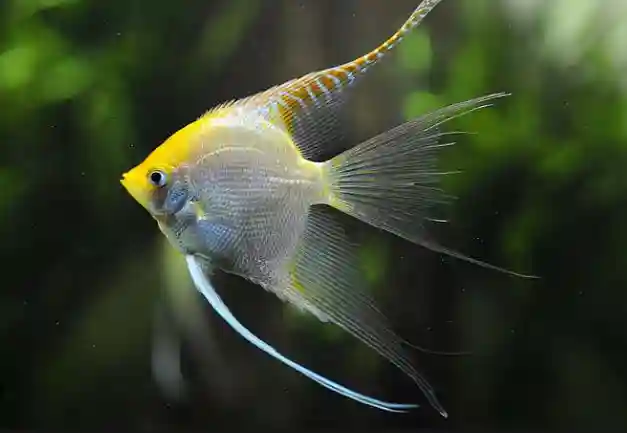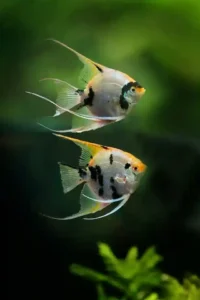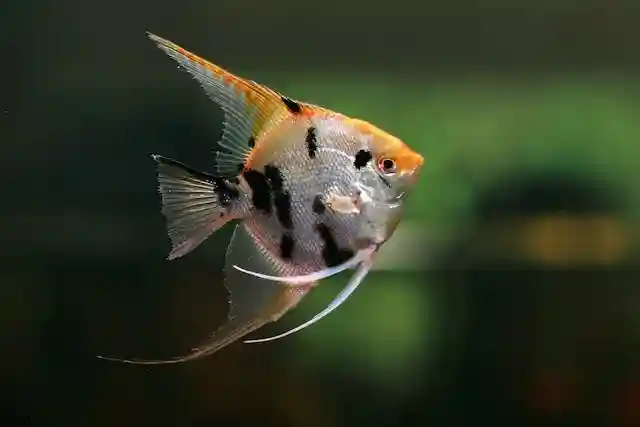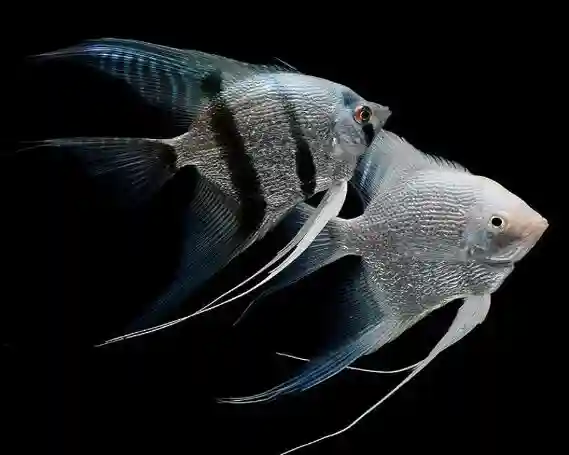Freshwater angelfish are a beautiful species, known for their vibrant colors and graceful appearance. If you’re considering adding these aquatic gems to your home aquarium or just want to learn more about them, you’ve come to the right place. In this article, we’ll explore everything you need to know about freshwater angelfish, from their origins to care tips and FAQs.
A Closer Look of Freshwater Angelfish
Freshwater angelfish, scientifically known as Pterophyllum scalare, are native to the Amazon River basin in South America. Their striking appearance and peaceful nature make them a sought-after addition to aquariums around the world. These elegant fish are often referred to as “angelfish” due to their distinctive, triangular shape. Let’s dive into the world of freshwater angelfish and uncover the secrets to keeping them happy and healthy in your aquarium.
What are the characteristics of Pterophyllum scalare?
Freshwater angelfish are characterized by their unique appearance. They have tall, triangular bodies with elongated dorsal and anal fins that resemble angelic wings, hence their name. Here’s what you should know:

Characteristics of Freshwater Angelfish
| Characteristic | Description |
|---|---|
| Scientific Name | Pterophyllum scalare |
| Common Name | Freshwater Angelfish |
| Origin | Amazon River basin, South America |
| Body Shape | Tall, triangular with flowing fins |
| Color Variations | Silver, black, marbled patterns |
| Temperament | Generally peaceful, can become territorial during breeding |
| Tank Size | At least 20 gallons |
| Water Temperature | 75-82°F (24-28°C) |
| pH Level | 6.5-7.5 |
| Diet | Omnivorous, flakes, pellets, live/frozen foods |
| Compatibility | Compatible with peaceful species, avoid aggressive fish |
| Lifespan | 10-15 years with proper care |
| Breeding Behavior | Excellent parents, guard their fry |
| Disease Susceptibility | Susceptible to common aquarium diseases |
| Tank Decor | Plants, caves, driftwood for hiding and security |
| Unique Behaviors | Graceful swimming, exploring their environment |
| Pair Bonds | Form pair bonds during breeding |
Origins and Habitat: Angelfish
Freshwater angelfish hail from the warm, slow-moving waters of the Amazon River and its tributaries. Their natural habitat consists of dense vegetation, fallen branches, and submerged tree roots. To mimic this environment, consider adding live plants and driftwood to your aquarium.
Angelfish: Physical Characteristics
These graceful fish come in various color variations, including silver, black, and marbled patterns. Their striking vertical stripes and flowing fins make them a sight to behold. When selecting angelfish for your aquarium, choose healthy specimens with vibrant colors and no visible signs of illness.

Temperament
Freshwater angelfish are generally peaceful. But they can become territorial during breeding. It’s best to keep them in small groups to reduce aggression. Avoid pairing them with aggressive or nippy fish species.
Generally Peaceful: Freshwater angelfish are typically considered peaceful fish. They are not known for aggressive behaviors and tend to coexist well with other non-aggressive species.
Territorial Behavior: While angelfish are peaceful, they can display territorial behavior, especially during breeding. When they form pairs and decide to breed, they may become protective of their chosen breeding site and become more assertive.
Intraspecies Compatibility: Angelfish usually get along with other angelfish, particularly when kept in groups or pairs. They often form strong pair bonds and may become more territorial when breeding.
Interspecies Compatibility: Compatibility with other fish species depends on the temperament of the tankmates. Avoid aggressive or nippy fish that may harass or stress the angelfish.
Suitable tankmates for angelfish include peaceful community fish such as tetras, gouramis, corydoras catfish, and other similarly sized, non-aggressive species.
Individual Variability: It’s important to remember that individual angelfish may have varying temperaments. Some may be more docile, while others might be slightly more territorial.
Observe the behavior of your angelfish when introducing them to the tank and monitor their interactions with other fish to ensure compatibility.
Size and Space Consideration: Angelfish can grow relatively large, with adult sizes of up to 6 inches (15 cm) or more. Ensure that the tank size and layout provide enough space for them to establish territories without overcrowding.
Breeding Behavior: During the breeding process, angelfish become more protective of their nesting site and may chase away other fish that venture too close. It’s advisable to provide them with a separate breeding tank during this time to prevent conflicts.
Observation and Adjustments: Regularly observe the behavior of your angelfish and their interactions with tankmates. If you notice signs of aggression or stress, consider reorganizing the tank or removing aggressive individuals.
Group Dynamics: In larger groups of angelfish, aggression is often less pronounced because aggression is spread out among more individuals. However, larger groups may require a more spacious tank.
Tank Setup for Freshwater Angelfish
For a comfortable habitat, provide your angelfish with a tank of at least 20 gallons. Maintain a water temperature between 75-82°F (24-28°C) and a pH level of 6.5-7.5. Install a good filtration system to keep the water clean, as these fish are sensitive to water quality.
Tank Size:
- Freshwater angelfish require a spacious tank to accommodate their size and swimming needs. A tank with a capacity of at least 20 gallons is recommended for a small group of angelfish.
Filtration:
- Adequate filtration is essential to maintain water quality. A good-quality filter should be able to handle the volume of your tank and provide efficient mechanical and biological filtration.
Water Temperature and Parameters:
- Freshwater angelfish prefer a stable water temperature in the range of 75 to 82 degrees Fahrenheit (24 to 28 degrees Celsius).
- Maintain a slightly acidic pH level between 6.0 and 7.0.
- Monitor water hardness (GH) and alkalinity (KH) to ensure they are within suitable ranges for angelfish.
Substrate:
- Choose a fine gravel or sand substrate for the bottom of the tank. Angelfish sometimes like to dig and sift through the substrate, so avoid using sharp or coarse materials.
Tank Decor:
- Create a natural and visually appealing environment by adding live or artificial plants. Angelfish enjoy tall plants that provide hiding spots and shaded areas.
- Incorporate driftwood and rocks to mimic their natural habitat in the Amazon River Basin.
- Use caves or PVC pipes as potential hiding places, especially if you plan to breed angelfish.
Lighting: Provide moderate lighting in the aquarium. Avoid excessively bright or harsh lighting, as angelfish prefer subdued lighting conditions.
Aeration: Ensure proper aeration to maintain oxygen levels in the water. Angelfish breathe through their gills and require well-oxygenated water for their health.
Water Movement: Freshwater angelfish are used to slow-moving waters in their natural habitat. Use gentle water movement in the tank to simulate these conditions. Avoid strong currents.
Heating: Use an aquarium heater to maintain a consistent water temperature within the recommended range. Make sure to have a reliable thermometer to monitor the temperature.
Maintenance: Perform regular water changes to remove accumulated waste and maintain water quality. Aim for a 20% to 25% water change every 2-4 weeks.
Feeding Angelfish

Angelfish are omnivores and enjoy a varied diet. Offer them high-quality flake food, pellets, and frozen or live foods like brine shrimp and bloodworms. Remember to feed them in small, frequent portions to prevent overeating.
Omnivorous Diet: Freshwater angelfish are omnivores, which means they consume both plant matter and small aquatic organisms in their natural habitat. It’s essential to replicate this varied diet in captivity.
Commercial Fish Food: High-quality commercial fish food is the foundation of their diet. Look for specially formulated angelfish flakes or pellets that provide essential nutrients.
Feed them a variety of commercial foods to ensure they receive a wide range of nutrients. Rotate between different brands and types of pellets or flakes.
Live and Frozen Foods: Freshwater angelfish appreciate live or frozen foods as occasional treats. Offer them foods like brine shrimp, bloodworms, daphnia, and blackworms to add variety to their diet.
Live foods are not only nutritionally beneficial, but they also stimulate their natural hunting instincts.
Fresh Vegetables: To incorporate plant matter into their diet, you can occasionally offer blanched vegetables such as spinach, zucchini, or cucumber. These should be soft and easy for them to eat.
Frequency and Portion Control: Feed your angelfish small, frequent meals throughout the day. It’s better to feed them several times a day with small portions rather than one large meal.
Monitor their feeding behavior to avoid overfeeding, which can lead to obesity and water quality issues. Only provide what they can consume in a few minutes.
Nutritional Supplements: Consider using high-quality fish food with added vitamins and minerals to ensure they receive a balanced diet.
Occasionally, you can supplement their diet with vitamin-enriched fish food or liquid supplements to boost their overall health.
Feeding Behavior: Observe their feeding behavior. Healthy angelfish are active eaters and will readily come to the surface to feed.
If you notice any angelfish not eating or showing signs of reduced appetite, it could be an early indication of health issues. Investigate and address the problem promptly.
Water Quality: Maintain excellent water quality in the tank. High water quality is essential for healthy digestion and nutrient absorption.
Compatibility with Tankmates: Ensure that tankmates share similar dietary requirements to prevent competition for food. Choose tankmates that won’t outcompete the angelfish for food.
Breeding and Fry Diet: When angelfish are breeding and caring for fry, provide them with specialized fry food or finely crushed flakes to meet the needs of the developing young.
Freshwater Angelfish Care
Ensuring the well-being of your freshwater angelfish requires attention to detail and a nurturing approach. Let’s delve into the key aspects of caring for these aquatic beauties:
Water Quality
Maintaining pristine water conditions is paramount. Perform regular water changes to remove waste and keep ammonia and nitrite levels low. Invest in a reliable water testing kit to monitor water parameters.
- Maintain excellent water quality by regularly testing the parameters. Freshwater angelfish prefer a stable environment.
- Keep the water temperature between 75 to 82 degrees Fahrenheit (24 to 28 degrees Celsius) and maintain a pH level between 6.0 and 7.0.
- Monitor ammonia, nitrite, and nitrate levels and perform regular water changes to keep these parameters in check.
Tank Mates for Angelfish
Choose tank mates carefully. Compatible species include neon tetras, Corydoras catfish, and peaceful gouramis. Avoid aggressive or fin-nipping fish that could stress your angelfish.
- Choose tankmates carefully. Angelfish are generally peaceful but can become territorial during breeding.
- Ideal tankmates include peaceful community fish such as tetras, gouramis, corydoras catfish, and other non-aggressive species.
- Avoid aggressive or nippy fish that may harass angelfish.
| Category | Suitable Tank Mates for Angelfish |
|---|---|
| Tetras | Neon tetras, Cardinal tetras, Rummy-nose tetras, Serpae tetras, Ember tetras |
| Gouramis | Dwarf gouramis, Honey gouramis, Pearl gouramis, Sparkling gouramis |
| Corydoras Catfish | Bronze corydoras, Peppered corydoras, Panda corydoras, Sterbai corydoras |
| Rasboras | Harlequin rasboras, Chili rasboras, Lambchop rasboras |
| Danios | Zebra danios, Pearl danios, Leopard danios |
| Livebearers | Platies, Swordtails, Endler’s livebearers, Guppies |
| Other Peaceful Community Fish | Cherry barbs, Rosy barbs, Hatchetfish, Kuhli loaches, Rainbowfish (larger species), Dwarf rainbowfish |
| Bottom-Dwelling Fish | Bristlenose plecos, Hillstream loaches, Kuhli loaches, Dwarf cichlids (e.g., Apistogramma species) |
Breeding Freshwater Angelfish
If you’re interested in breeding angelfish, provide them with a flat surface like a broad leaf or slate for egg-laying. The angelfish makes excellent parents, with both parents guarding the fry.
- If you plan to breed angelfish, provide them with flat surfaces for egg laying, such as broad leaves, rocks, or PVC pipes.
- Be prepared to separate breeding pairs into a dedicated breeding tank to protect the eggs and fry from potential threats.
Disease Prevention for Angelfish
Freshwater angelfish are susceptible to common aquarium diseases. Quarantine new fish before introducing them to your main tank to prevent disease outbreaks. Keep an eye out for signs of illness, such as lethargy or loss of appetite.
- Regularly observe the behavior and appearance of your angelfish. Any signs of illness, such as lethargy, loss of appetite, or abnormal behavior, should be addressed promptly.
- Quarantine new fish before introducing them to the main tank to prevent the spread of diseases.

Tank Decor
Create a natural environment with plenty of hiding spots. Freshwater angelfish appreciate the security of plants, caves, and driftwood. These elements also encourage natural behaviors and reduce stress.
- Create an aesthetically pleasing environment with attention to detail. Angelfish appreciate a well-decorated tank.
- Use fine gravel or sand substrate, and provide hiding places with driftwood, caves, and tall plants.
Conclusion
Freshwater angelfish are a lovely addition to any aquarium, bringing beauty and peace to your aquarium. You can enjoy these beautiful fish for many years as a pet. So, why wait? Dive into the world of freshwater angelfish and create a booming underwater ecosystem in your home. With their rich colors and peaceful presence, these fish will surely bring joy to your aquarium.
Frequently Asked Questions (FAQs)
What is the lifespan of freshwater angelfish?
Freshwater angelfish can live for 10-15 years when provided with proper care and a suitable environment.
How many angelfish can I keep in a 20-gallon tank?
In a 20-gallon tank, it’s advisable to keep a small group of 3-4 angelfish.
Do angelfish require special lighting in their tank?
While angelfish don’t have specific lighting requirements, providing them with a natural day-night cycle can promote their well-being.
Can I keep angelfish with other species of fish?
Yes, but choose tank mates carefully. Peaceful and non-aggressive species are the best companions for angelfish.
How can I differentiate between male and female angelfish?
Males typically have a more pronounced and elongated dorsal fin, while females have a broader body shape. During breeding, you may also notice differences in behavior.
Do angelfish display any unique behaviors?
Yes, angelfish are known for their graceful swimming patterns and the way they explore their environment. They also form pair bonds during breeding.






